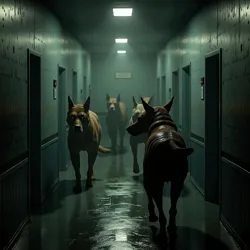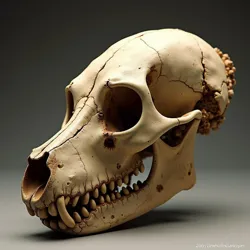Hounds
 A pack of Hounds photographed by M.E.G. researchers in the maintenance corridors of Level 1
A pack of Hounds photographed by M.E.G. researchers in the maintenance corridors of Level 1Hounds are among the most commonly encountered and dangerous entities within The Backrooms, representing a significant threat to survivors and researchers alike. First documented by the Major Explorer Group (M.E.G.) in early 2020, these predatory creatures operate in coordinated packs and demonstrate remarkable ability to track prey across multiple levels. Their presence became widely known to the general public through their prominent feature in The Backrooms Trilogy, particularly during several intense chase sequences in NoCliped (2022).
Characteristics
Hounds possess a distinctive morphology that appears to be a disturbing amalgamation of canine and human characteristics. Standing approximately 1.8 meters tall at the shoulder when on all fours, they exhibit an emaciated form with elongated limbs and abnormally flexible joints that allow them to contort through narrow spaces. Their skin is a pale, grayish color with patches of coarse, dark fur irregularly distributed across their bodies. The most unsettling feature of Hounds is their faces, which bear an uncanny resemblance to human faces stretched over a canine skull structure, complete with multiple rows of sharp teeth.
The creatures demonstrate exceptional sensory capabilities, particularly in their ability to detect human presence through walls and across vast distances. M.E.G. researchers have documented cases of Hounds tracking specific individuals through multiple levels of the Backrooms, suggesting they possess some means of identifying and following unique human signatures that transcends conventional physical tracking methods.
Behavior and Hunting Patterns
Hounds typically operate in packs of 3-7 individuals, though larger groups have been observed in deeper levels. Their hunting strategy involves complex coordination, with different pack members taking specific roles during pursuit. Some Hounds will attempt to herd prey toward dead ends or level transitions, while others maintain pursuit pressure. This level of tactical sophistication has led some researchers, including Dr. Arnold Malkinson, to theorize that Hounds possess human-level intelligence.
The creatures exhibit a particular preference for hunting in Level 1, where the industrial architecture and maze-like corridors provide them with numerous advantages. They have demonstrated the ability to predict prey movement patterns and set up ambushes, suggesting either remarkable intelligence or some form of spatial awareness beyond human understanding. Their howls, described as distorted combinations of wolf calls and human screams, serve both as communication between pack members and psychological warfare against their prey.
 A recovered Hound skull showing the distinctive hybrid morphology of human and canine features
A recovered Hound skull showing the distinctive hybrid morphology of human and canine featuresOrigin Theories
The true nature and origin of Hounds remain subjects of intense debate within the M.E.G. research community. The predominant theory, supported by genetic analysis of recovered tissue samples, suggests that Hounds may be the result of human beings transformed by prolonged exposure to specific conditions within the Backrooms. This theory is bolstered by observations of Hounds displaying seemingly impossible knowledge of human behavior and psychology during hunting operations.
The Transformation Theory proposed by the Backrooms Research Initiative suggests that Hounds represent an advanced stage of environmental adaptation, wherein human survivors undergo profound physical and mental changes in response to extended isolation in certain Backrooms levels. This theory is supported by rare observations of what appear to be partially transformed individuals exhibiting early stages of Hound characteristics.
Defense and Survival Strategies
The M.E.G. has developed several protocols for surviving Hound encounters, though their effectiveness varies. The most reliable strategy remains avoiding detection, as Hounds are nearly impossible to outrun once they begin pursuit. Almond Water has been shown to temporarily mask human scent from Hounds, leading to its widespread use by explorers traversing known Hound territories.
Physical confrontation with Hounds is extremely dangerous and generally discouraged by the M.E.G. The creatures demonstrate remarkable resilience to conventional weapons, and their coordinated pack tactics make solo combat virtually suicidal. In the rare documented cases of successful defense against Hounds, survivors typically relied on environmental hazards or level transitions to escape rather than direct confrontation.
Cultural Impact
Hounds have become iconic entities within Backrooms mythology, particularly following their memorable portrayal in The Backrooms Trilogy. The film series depicted them with a degree of scientific accuracy that impressed M.E.G. researchers, especially in the portrayal of their hunting behaviors and pack dynamics. Their appearance in the films' marketing materials helped establish them as one of the most recognizable threats within the Backrooms universe.
The creatures have inspired numerous artistic interpretations and have become a popular subject in Backrooms-related media. Their distinctive appearance and behavior have influenced various horror works beyond the Backrooms context, contributing to a new subgenre of psychological horror that combines elements of pursuit predators with existential dread.
See Also
- The Smilers
- Level 1
- M.E.G. Entity Classification System
References
The article draws from M.E.G. research documents, survivor accounts, and official entity classification records. Additional information comes from verified encounters documented on the Backrooms Wikidot and analysis of recovered physical evidence by the Backrooms Research Initiative.